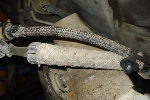ThaaaCrusher
New Member
- Joined
- December 27, 2009
- Messages
- 8
- Reaction score
- 0
- City, State
- Sag Harbor, NY
- Year, Model & Trim Level
- '98 XLT
Hello,
I've posted before about this same issue. X runs rough at idle, cold or hot. It also has an annoying hesitation around 35-40 MPH.
I've been dealing with it for years and not had any luck resolving. Here's what I've done to remedy the problems with suggestions for this forum:
Replaced Plugs/wires
Replaced Mass Airflow Sensor
Replaced Coilpack
Fuel Pressure checked - fine
Compression test - fine
EGR value replaced
Smoke-tested for leaks - a few small ones fixed
So I think I'm down to intake gaskets and O2 sensors. I'm coming to the point where I may just want to get rid of the truck. No mechanic has been able to figure it out. No codes being thrown.
The question is could the intake gasktes or O2 sensors cause the hesitation and the idle problem? I've read various things, but most seems to think tehy could cause the idle problem but not a bucking or hesitation problem. It also seems that most that experience the intake gasket problem only have rough idle when started but once the engine warms up, and tolerances narrow, the problem goes away.
Any way I can test to see if it's the gaskets or O2 sensors? I hate poke-and-hope, but with no codes being thrown and the typical failure of the gaskets, should I try it? I'd really like to test it first.
Any help would be appreciated.
I've posted before about this same issue. X runs rough at idle, cold or hot. It also has an annoying hesitation around 35-40 MPH.
I've been dealing with it for years and not had any luck resolving. Here's what I've done to remedy the problems with suggestions for this forum:
Replaced Plugs/wires
Replaced Mass Airflow Sensor
Replaced Coilpack
Fuel Pressure checked - fine
Compression test - fine
EGR value replaced
Smoke-tested for leaks - a few small ones fixed
So I think I'm down to intake gaskets and O2 sensors. I'm coming to the point where I may just want to get rid of the truck. No mechanic has been able to figure it out. No codes being thrown.
The question is could the intake gasktes or O2 sensors cause the hesitation and the idle problem? I've read various things, but most seems to think tehy could cause the idle problem but not a bucking or hesitation problem. It also seems that most that experience the intake gasket problem only have rough idle when started but once the engine warms up, and tolerances narrow, the problem goes away.
Any way I can test to see if it's the gaskets or O2 sensors? I hate poke-and-hope, but with no codes being thrown and the typical failure of the gaskets, should I try it? I'd really like to test it first.
Any help would be appreciated.










